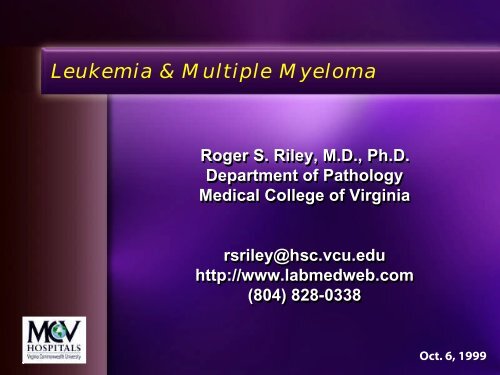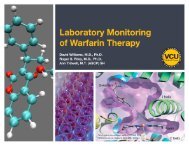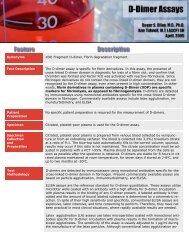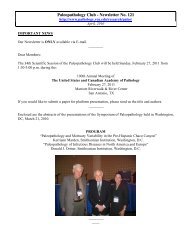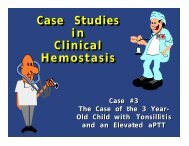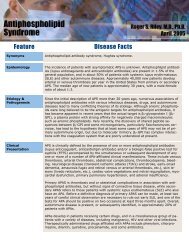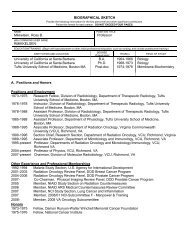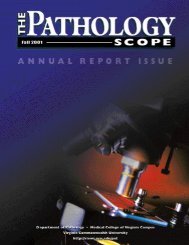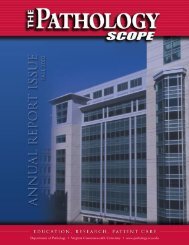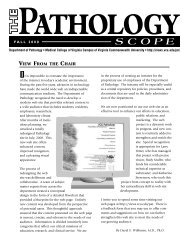Leukemia Lecture Part 1 - Pathology
Leukemia Lecture Part 1 - Pathology
Leukemia Lecture Part 1 - Pathology
You also want an ePaper? Increase the reach of your titles
YUMPU automatically turns print PDFs into web optimized ePapers that Google loves.
<strong>Leukemia</strong> & Multiple Myeloma<br />
Roger S. Riley, M.D., Ph.D.<br />
Department of <strong>Pathology</strong><br />
Medical College of Virginia<br />
rsriley@hsc.vcu.edu<br />
http://www.labmedweb.com<br />
(804) 828-0338<br />
Oct. 6, 1999
Goals & Objectives<br />
■ Understand nature and etiology<br />
■ Understand classification<br />
■ Understand clinical manifestations<br />
■ Understand principles of diagnosis<br />
■ Understand prognostic factors<br />
■ Understand principles of treatment
<strong>Lecture</strong> Contents<br />
■ Basic features<br />
■ Acute leukemias<br />
■ Chronic leukemias<br />
■ Multiple myeloma<br />
■ Summary
<strong>Lecture</strong> Contents<br />
■<br />
■<br />
■<br />
Basic features<br />
Definition<br />
Classification<br />
Clinical features<br />
Etiology<br />
Diagnosis<br />
Acute leukemias<br />
Chronic leukemias
What is<br />
leukemia ?<br />
Malignant<br />
neoplasm of the<br />
white blood cell,<br />
characterized<br />
by involvement<br />
of the blood and<br />
bone marrow !
<strong>Leukemia</strong> Features<br />
Acute<br />
Chronic<br />
Onset Rapid Gradual<br />
Cell type<br />
Immature<br />
(Blast)<br />
More Mature<br />
Survival Fatal if no Rx Long survival<br />
Treatment<br />
Amenable to<br />
chemotherapy<br />
May be resistant
Clinical Features of <strong>Leukemia</strong><br />
Replacement of<br />
normal marrow<br />
elements<br />
Production of<br />
physiologically<br />
active substances<br />
Anemia<br />
Bleeding<br />
Infection<br />
Leukostasis and<br />
tissue infiltration
Normal Hematopoiesis<br />
Pluripotential Stem Cell<br />
Lymphoid<br />
Stem Cell<br />
Myeloid<br />
Stem Cell<br />
Differentiation<br />
&<br />
Maturation<br />
T<br />
B
<strong>Leukemia</strong> Classification<br />
Acute<br />
Chronic<br />
Lymphoid<br />
ALL<br />
CLL<br />
Myeloid<br />
AML<br />
CML
<strong>Leukemia</strong> Diagnosis<br />
Light<br />
Microscopy<br />
(Morphology)<br />
Electron<br />
Microscopy<br />
(Ultrastructure)<br />
Immunophenotypic<br />
Analysis<br />
(Antigens)<br />
1900 1950 2000<br />
Cytochemical<br />
Stains<br />
(Enzymes)<br />
Cytogenetic<br />
Analysis<br />
(Chromosomes)<br />
Molecular<br />
Techniques<br />
(Genes)
<strong>Lecture</strong> Contents<br />
■<br />
■<br />
■<br />
■<br />
■<br />
Basic features<br />
Acute leukemias<br />
Etiology<br />
Acute lymphoblastic leukemia<br />
Acute myeloblastic leukemia<br />
Chronic leukemias<br />
Multiple myeloma<br />
Summary
Pluripotential<br />
Stem Cell<br />
Lymphoid<br />
Stem Cell<br />
Myeloid<br />
Stem Cell<br />
T<br />
B
Acute <strong>Leukemia</strong> and Age<br />
■ ALL is primarily a<br />
pediatric disease<br />
■ AML is primarily<br />
an adult disease<br />
% Patients % Patients<br />
100<br />
80<br />
60<br />
40<br />
Myeloblastic<br />
20<br />
0<br />
Lymphoblastic<br />
0 20 40 60 > 70<br />
Age
<strong>Lecture</strong> Contents<br />
■<br />
■<br />
■<br />
■<br />
■<br />
Basic features<br />
Acute leukemias<br />
Etiology<br />
Acute lymphoblastic leukemia<br />
Acute myeloblastic leukemia<br />
Chronic leukemias<br />
Multiple myeloma<br />
Summary
Acute Lymphoblastic <strong>Leukemia</strong><br />
■ Abrupt stormy onset<br />
■ Symptoms related to suppressed BM<br />
Fatigue (anemia)<br />
Fever/infection (leukopenia)<br />
Bleeding/bruising (thrombocytopenia)<br />
■ Bone pain/tenderness<br />
■ Lymphadenopathy, hepatosplenomegaly<br />
■ CNS involvement
Acute Lymphoblastic <strong>Leukemia</strong><br />
■ Proliferation of<br />
lymphoblasts<br />
■ Small cells with<br />
indistinct nucleoli<br />
■ High nuclear/<br />
cytoplasmic ratio<br />
■ Fine chromatin
Peripheral Blood in ALL
Bone Marrow in ALL
FAB Classification<br />
■ Standard morphologic classification<br />
system<br />
■ French-American-British Cooperative<br />
Group<br />
■ Features considered<br />
Cell size<br />
Amount of cytoplasm<br />
Nuclear vacuolarion<br />
Nuclear size and shape<br />
Cytoplasmic vacuolations<br />
Other features
FAB Classification<br />
■ Acute Lymphoblastic <strong>Leukemia</strong><br />
Three Subtypes<br />
L1, L2, L3<br />
■ Acute Myelogenous <strong>Leukemia</strong><br />
Eight Subtypes<br />
M0, M1, M2, M3,<br />
M4, M5, M6, M7
Cytochemistry of ALL<br />
■ Positive for TdT<br />
(terminal deoxytransferase)<br />
■ Negative for<br />
myeloperoxidase
Immunology of ALL<br />
■ Pre-B ALL (FAB-L1 or L2)(85%)<br />
CD10 (CALLA)<br />
CD19<br />
Children and adults<br />
■ T-ALL (FAB-L1 or L2)(15%)<br />
Adolescent males<br />
Thymic mass<br />
■ B-ALL (ALL-L3)(< 1%)<br />
Related to Burkitt’s lymphoma<br />
Poorer prognosis
Immunology of ALL
Lymphoblastic Lymphoma
ALL, FAB-L3<br />
■ Leukemic counterpart<br />
of Burkitt’s lymphoma<br />
■ Endemic in parts of<br />
Africa<br />
■ Large cells with blue<br />
vacuolated cytoplasm<br />
■ Express monoclonal<br />
immunoglobulin light<br />
chain (usually λ)<br />
■ t(8;14), c-<br />
oncogene<br />
■ Associated with EBV<br />
infection
Cytogenetics in ALL<br />
■ 90% have chromosomal<br />
abnormality<br />
Hyperdiploidy (>50<br />
chromosomes)<br />
Translocations (e.g. t(9;22))<br />
■ Prognostic significance
Treatment of ALL<br />
■ Three treatment phases<br />
Remission induction<br />
Consolidation (intensification)<br />
Maintenance<br />
■ Allopurinol to counter hyperuricemia<br />
from tumor cell breakdown<br />
■ CNS prophylaxis<br />
■ 70-85% cure rate in children, worse<br />
prognosis in adults
Post-Chemotherapy Marrow
<strong>Lecture</strong> Contents<br />
■<br />
■<br />
■<br />
■<br />
■<br />
Basic features<br />
Acute leukemias<br />
Etiology<br />
Acute lymphoblastic leukemia<br />
Acute myeloblastic leukemia<br />
Chronic leukemias<br />
Multiple myeloma<br />
Summary
Pluripotential<br />
Stem Cell<br />
Lymphoid<br />
Stem Cell<br />
Myeloid<br />
Stem Cell<br />
T<br />
B
FAB Classification of AML<br />
M0, M1, M2<br />
M3<br />
M4<br />
M5<br />
M6<br />
M7<br />
Myeloblastic<br />
Promyelocytic<br />
Myelomonocytic<br />
Monoblastic<br />
Erythroblastic<br />
Megakaryoblastic
Acute Myelogenous <strong>Leukemia</strong><br />
■<br />
■<br />
■<br />
■<br />
■<br />
■<br />
■<br />
Proliferation of immature “myeloid” cells<br />
Primarily occurs in adults<br />
Develops in some patients with<br />
chemotherapy, radiotherapy, etc.<br />
Abrupt presentation with anemia, infection,<br />
and/or bleeding<br />
Myeloblasts may have<br />
Extramedullary involvement in FAB M4 and<br />
M5 (gums, skin, internal organs)<br />
DIC in acute promyelocytic leukemia (FAB<br />
M3)
Causes of AML<br />
■ Idiopathic (vast majority)<br />
■ Prior chemotherapy<br />
■ Prior radiotherapy<br />
■ Chemical exposure (benzene)<br />
■ Myelodysplastic syndromes<br />
■ Myeloproliferative diseases<br />
■ Down’s syndrome<br />
■ Fragile chromosome syndromes<br />
■ Aplastic anemia and PNH
Morphology of AML
Cytochemistry of AML<br />
■ Myeloperoxidase<br />
positive<br />
■ TdT negative
Immunology of AML<br />
■ Positive for myelo/monocytic Ags<br />
CD13, CD33<br />
■ Negative for B-lineage antigens<br />
CD10, CD19<br />
■ Negative for T-lineage antigens<br />
CD3, CD7
Immunology of ALL
Cytogenetics of AML<br />
■ 90% have chromosomal<br />
abnormalities<br />
■ t(15;17)- APL<br />
■ t(8;21)<br />
■ -5<br />
■ -7<br />
■ +8
Acute Promyelocytic <strong>Leukemia</strong><br />
■ Neoplastic<br />
promyelocytes<br />
■ Many Auer rods<br />
■ DIC<br />
■ t(15;17)<br />
RAR gene on 17<br />
■ Treated with<br />
retinoic acid
Treatment of AML<br />
■ AML M0-M2, M4-M7<br />
Induction chemotherapy<br />
Intensification (consolidation)<br />
Initial remission in 65% of patients<br />
Overall survival not as good as ALL<br />
Bone marrow transplantation used<br />
when possible<br />
■ AML FAB-M3<br />
Trans-retinoic acid<br />
Relatively good prognosis


